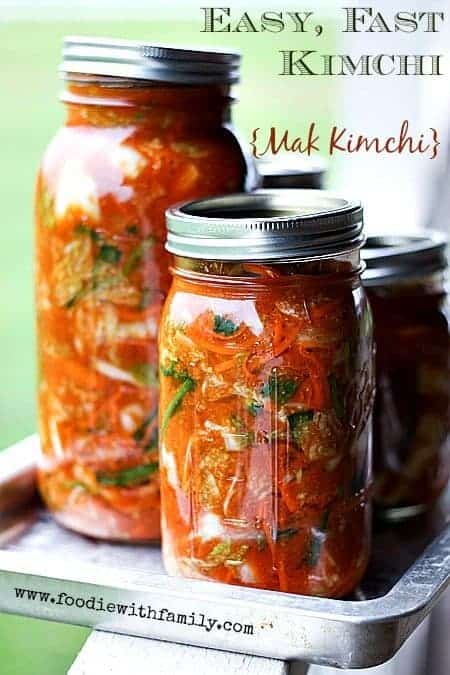
Love this Easy, Fast Mak Kimchi recipe? Check out our other fabulous Korean Food Recipes!
If you’ve been with me for a while, you’re well aware of my undying love for kimchi. Yes, it is stinky and bubbly and more than a little wild, but WOWZA the taste and the texture are so worth it.
If you’re new to the Foodie with Family family and you aren’t familiar with kimchi, I can give you a super condensed description; it’s essentially spicy, aromatic Korean sauerkraut. Today, I’m bringing you a fool-proof Easy Fast Kimchi recipe {Mak Kimchi}.
What is Kimchi?
Kimchi comes in almost as many forms as there are vegetables because nearly any vegetable can be fermented. They range from super mild smell to mega funky and mellow to melt-your-face-off spicy and there is one for every possible point in between.
The kimchi recipe that I’m sharing today is my family’s favourite version. It’s chock full of fabulous pro-biotics (as most kimchi is) and the longer it ages (translation: ferments) the stronger it becomes in both flavour AND pro-biotic content.
It’s like yogurt on steroids, people. That’s how good it is for you!
Is Kimchi Good For You?
Health Magazine named kimchi one of it’s Top 5 World’s Healthiest Foods. It is is low in calories and fat and high in dietary fiber and wicked high in Vitamins A, B, and C.
Many (if not most) Koreans eat a little kimchi with each meal or at least once a day. Kimchi is credited with helping most Koreans avoid obesity by virtue of its ability to satisfy even while being low calorie and low fat.
Seoul National University conducted a study and claimed that chickens infected with the H5N1 virus, also called avian flu, recovered after eating food containing the same cultured bacteria found in kimchi. That’s good enough for me!
How to Make Kimchi
Let’s get cracking and make some kimchi, shall we? The variety we’re making today is an Easy, Fast Kimchi recipe or Mak Kimchi…
In other words, it’s already cut up and ready to shovel into your mouth. Unlike what is usually just called ‘kimchi’ which is whole heads of napa cabbage smeared with the kimchi paste and allowed to ferment all wrapped up.
This version is FAR easier to make and far faster to be ready. Bonus, it is way easier to eat straight from the jar with a pair of chopsticks or a fork.
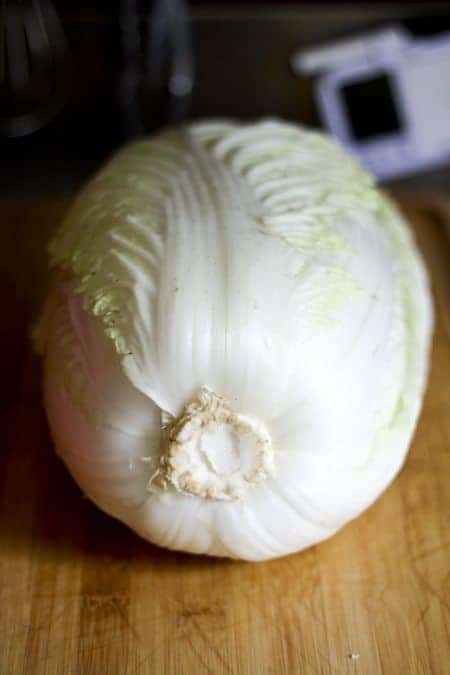
Do I need special tools to make kimchi?
In short, no. All you really need is a knife, a cutting board, and a big bowl. You will need a couple of ingredients that you may not have purchased before, but never fear, they’re not hard to find these days and I’ve included links to them below.
To begin with, you’ll need a big old head or two of Napa cabbage. I had two heads like the one above weighing in at about 3 pounds each.
It yielded, when all was said and done, about 3 quarts of kimchi, so that was perfect for me. You can cut that back if you think you can’t consume that amount of our Easy, Fast Kimchi recipe or Mak kimchi.
But I find all sorts of places to tuck it in, so it’s not an issue here and it’s only my husband, myself, and two of our boys who eat it. We love our kimchi.
Kimchi Recipe
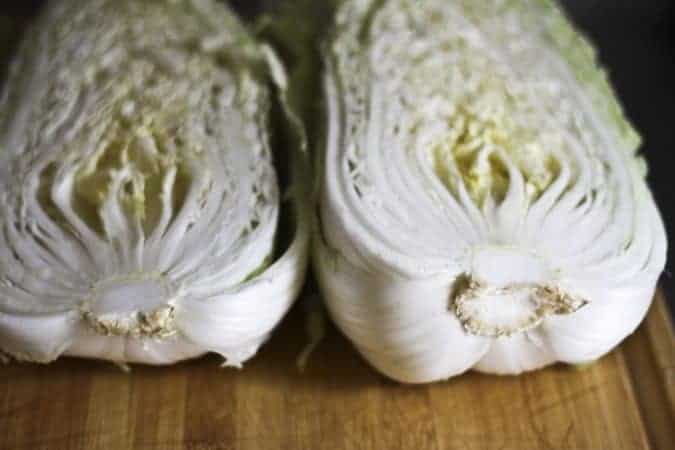
Lob your cabbages in half lengthwise. Use a paring knife to remove the gnarly core from them before cutting in half lengthwise again, leaving you with quarters.
Cut across the quarters to make bite-sized squares of cabbage. I usually shoot for 2-inch squares.
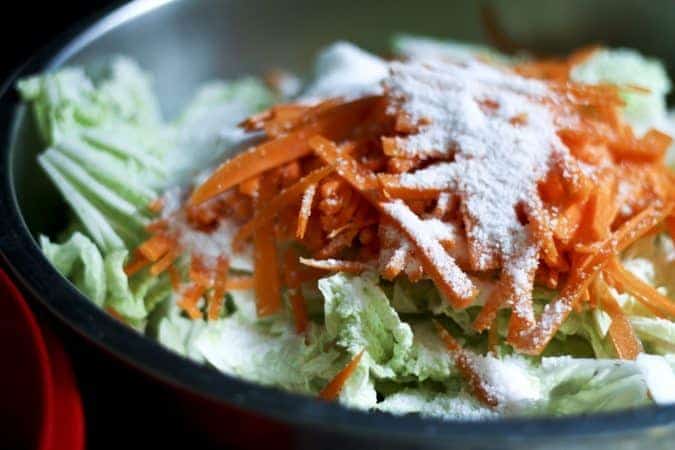
Add the cabbage to a monstrously huge bowl (or bowls), top with the julienned carrots, and sprinkle salt over the whole works. Toss the veggies and massage the mixture until the cabbage just starts to wilt.
Pour in enough cold water to over all the cabbage and carrots by a bit. It doesn’t have to be swimming in water, just covered.
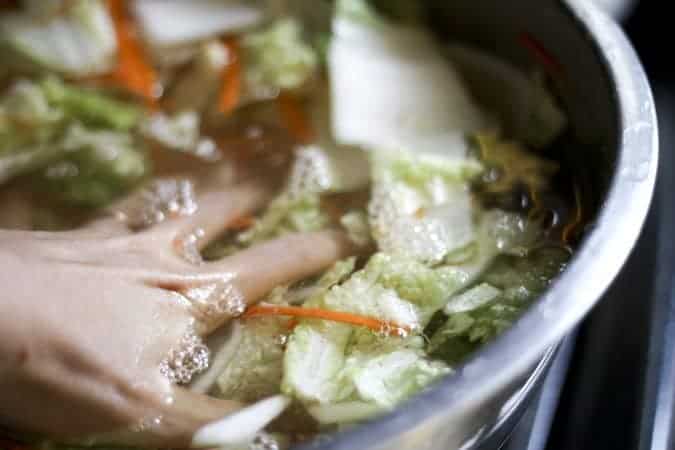
Stir it up with your hands and let it rest at room temp for a couple of hours.
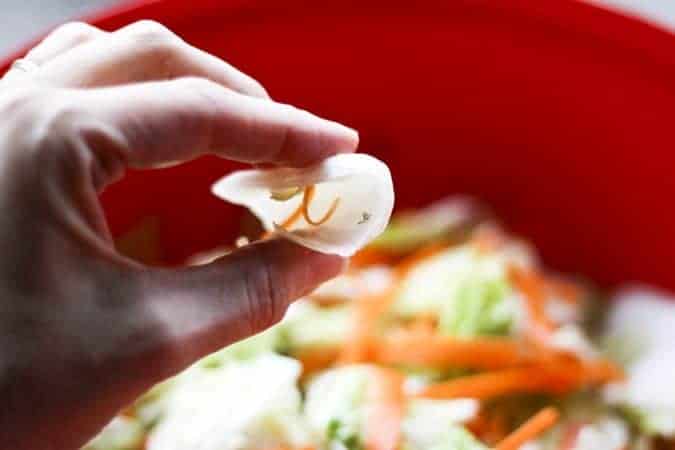
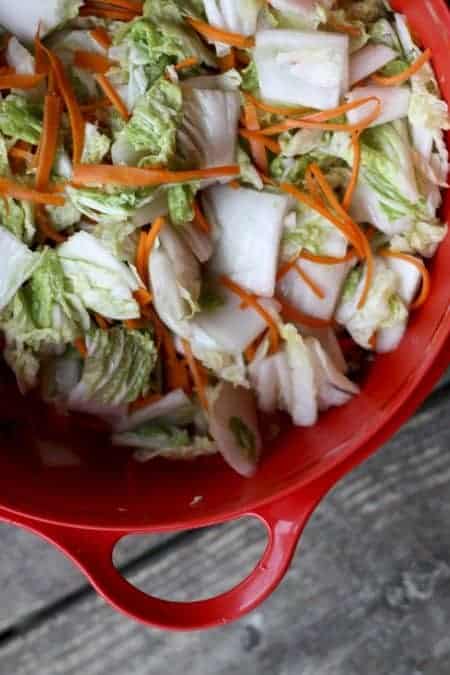
After a couple of hours, when the sturdier pieces of cabbage have become flexible, pour the whole lot into a strainer and let the brine water drain away.
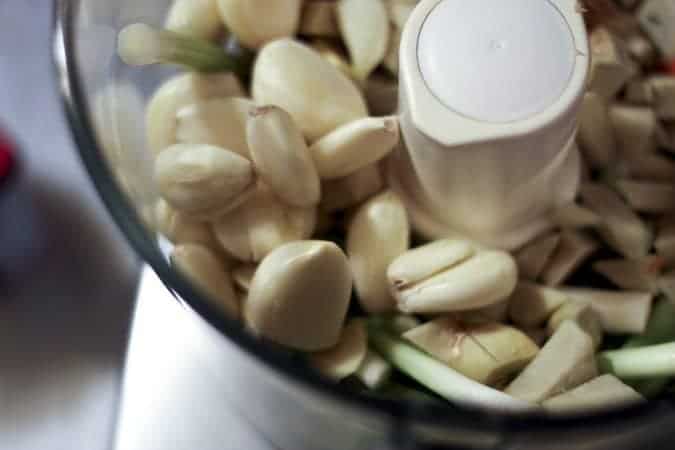
Now you’re going to whizz up the good stuff. Garlic, ginger, the white parts of scallions, Korean Red Pepper Powder*, fish sauce, unsweetened pear or apple juice, miso paste, and whatnot go into the food processor or blender.
Obliterate and smash it all into a lovely, red, fabulous smelling paste. It’s worth noting that you shouldn’t just up and increase the garlic because it can make kimchi linger more on your breath than you’d like it to do.
It also tastes out of balance if you add a lot more. Be aware.
And by the same token, you shouldn’t increase the ginger willy-nilly because that can make the final product a little more bitter than you’d like it to be. Start with the mixture and proportions I’m giving you and then play with it in subsequent batches.
*It’s important to note that you cannot use American or Mexican Chili Powder in place of the Korean pepper powder here. They’re COMPLETELY different animals. It may end up tasty, but I haven’t tested it so I cannot speak to it.
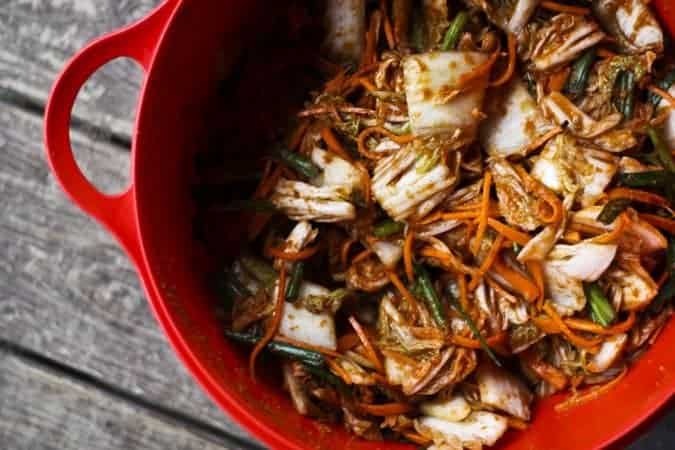
Now you’ll CRAM this stuff into jars or food-safe plastic containers. When I say cram it, I mean shove it in there as firmly as you can without putting your fist through the bottom of the jar.
I do prefer glass canning jars, if you’re wondering, because they don’t retain odors like plastic does, and, well, this stuff is odiferous! You can use a dedicated plastic kimchi bucket if you’d prefer, though.
Gently place a lid and ring on the jar, but don’t screw it tightly into place because BOOM. It’ll pop. This is active stuff, mes amies!
Place the jar on a rimmed pan or baking dish. The rim is pretty crucial here, because as the kimchi ferments at room temperature (and more slowly but still actively in the refrigerator) it will bubble up and may release a little juice over the edge of the jars.
In other words, you could have a kimchi river a-flowin’ on your counter top unless you take precautions. It’s easiest to use the pan and not worry about your Easy, Fast Kimchi recipe or Mak Kimchi bubbling over onto your counters.
It’s going to spend a couple of days at room temperature getting bubbly and fragrant. Every day, you’ll insert a clean chopstick or butter knife into the jar to help release air bubbles and top the jar off with extra brine if needed to keep everything submerged.
When it’s almost carbonated looking (usually between 24-72 hours after packing the jars), it’s ready to refrigerate. I highly recommend refrigerating it on the tray you used to contain the Grand Kimchi River while it fermented.
There aren’t a lot of things quite as unnecessary as removing everything from a fridge and mopping kimchi juices off of it. Take my word for it.
How long can I keep homemade kimchi?
It’s ready to eat at that point! Of course, it gets stronger and more kimchi-y the longer it sits. I love cooking with the older stuff and eating the newer stuff ‘raw’.
One of my all-time best-loved ways to eat older kimchi is in pancake form. Not like Aunt Jemima pancakes or flapjacks, but savoury, crispy-edged, kimchi-studded, pan-fried, snack cakes that convert even die-hard kimchi skeptics.
It’s the only way my eldest likes kimchi, but OH how he loves it this way. And the smell of kimchi pancakes while they cook is irresistible.
Bonus: This stuff lasts just about forever when you make sure the veggies are submerged in the brine. It’s hard to go wrong.
What can I make with my kimchi recipe? How do I use kimchi?
-Kimchi Fried Rice AND another version of Kimchi Fried Rice (the second one has a fried egg on top. SWOON!)
-Korean Army Stew- Budae Jjigae
-Kimchijeon (Savoury Kimchi Pancake)
Kimchi Ingredients
Kimchi
Cut the napa cabbage in half longways, then in half again longways. Cut the core out of the four quarters.
Cut the cabbage into squares (about 2-3 inches square), pop it in a bowl with the carrots. Sprinkle with the 1/2 cup kosher salt, massage so everything is coated in salt and starting to soften and wilt. Fill with cold, chlorine free water to cover it well and let it soak for at least 1 1/2 hours.
Pour the cabbage and carrots and liquid into a strainer. Let the brine drain away.
Lob off the white bits of the green onions and put them in a food processor with the garlic cloves, ginger, miso paste, and korean pepper powder. Zap it on high ’til it’s smooth-ish. Add in the fish sauce and a couple of slops of pear juice and zap it more until it’s about pancake batter consistency… maybe a bit thinner.
Put the brined cabbabe/carrots in a big, anti-reactive (glass, enamel, or stainless steel) bowl. Rough chop the green parts of the onions and add those to the cabbage/carrots. Pour the chili paste combo over the cabbage and wear gloves to massage it all over the cabbage/carrots green onions so everything is completely covered.
Pack super tight in canning jars. CRAM it in there.
Add a two-piece lid, but just set the ring in place to hold the lid down without screwing it in place. Place it on a rimmed baking dish to catch any spill-over.
Let it sit at room temperature for up to 72 hours, until it is bubbly and fragrant. Once every day, insert a clean chopstick or butter-knife to release air bubbles. If needed, pour in some additional brine to keep all the vegetables submerged.
Store on a rimmed sheet in the refrigerator for up to six months, being sure that the vegetables are submerged the whole time. The older it gets, the stronger it will become.
Notes
If you need extra brine to keep your vegetables submerged, please combine 1 quart of cool water with 4 teaspoons of kosher salt in a quart jar with a tight fitting lid and shake until the salt is dissolved. Use it to top off the vegetables as needed.
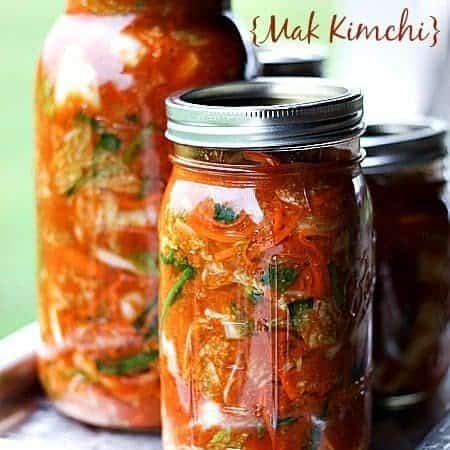
Easy, Fast Kimchi Recipe {Mak Kimchi}
Rate RecipeIngredients
- 3-8 pounds napa cabbage
- 2 bunches green onions trimmed of the root bits
- 2-3 large carrots peeled, thinly julienned
- 1/2 cup kosher salt
- 1/2 cup korean chili powder
- 15-20 cloves garlic overdoing garlic makes this stay on your breath more than usual., peeled
- 4-6 inches ginger peeled, rough chopped
- 1 tablespoon fish sauce
- unsweetened pear juice or unsweetened apple juice
- 4 tablespoons white miso paste
Instructions
- Cut the napa cabbage in half longways, then in half again longways. Cut the core out of the four quarters. Cut the cabbage into squares (about 2-3 inches square), pop it in a bowl with the carrots. Sprinkle with the 1/2 cup kosher salt, massage so everything is coated in salt and starting to soften and wilt. Fill with cold, chlorine free water to cover it well and let it soak for at least 1 1/2 hours.
- Pour the cabbage and carrots and liquid into a strainer. Let the brine drain away.
- Lob off the white bits of the green onions and put them in a food processor with the garlic cloves, ginger, miso paste, and korean pepper powder. Zap it on high ’til it’s smooth-ish. Add in the fish sauce and a couple of slops of pear juice and zap it more until it’s about pancake batter consistency… maybe a bit thinner.
- Put the brined cabbabe/carrots in a big, anti-reactive (glass, enamel, or stainless steel) bowl. Rough chop the green parts of the onions and add those to the cabbage/carrots. Pour the chili paste combo over the cabbage and wear gloves to massage it all over the cabbage/carrots green onions so everything is completely covered.
- Pack super tight in canning jars. CRAM it in there. Add a two-piece lid, but just set the ring in place to hold the lid down without screwing it in place. Place it on a rimmed baking dish to catch any spill-over. Let it sit at room temperature for up to 72 hours, until it is bubbly and fragrant. Once every day, insert a clean chopstick or butterknife to release air bubbles. If needed, pour in some additional brine to keep all the vegetables submerged.
- Store on a rimmed sheet in the refrigerator for up to six months, being sure that the vegetables are submerged the whole time. The older it gets, the stronger it will become.
Notes
Nutrition
Nutritional information is an estimate and provided to you as a courtesy. You should calculate the nutritional information with the actual ingredients used in your recipe using your preferred nutrition calculator.
did you make this recipe?
Make sure to tag @foodiewithfam on Instagram and #hashtag it #foodiewithfamily so I can check it out!
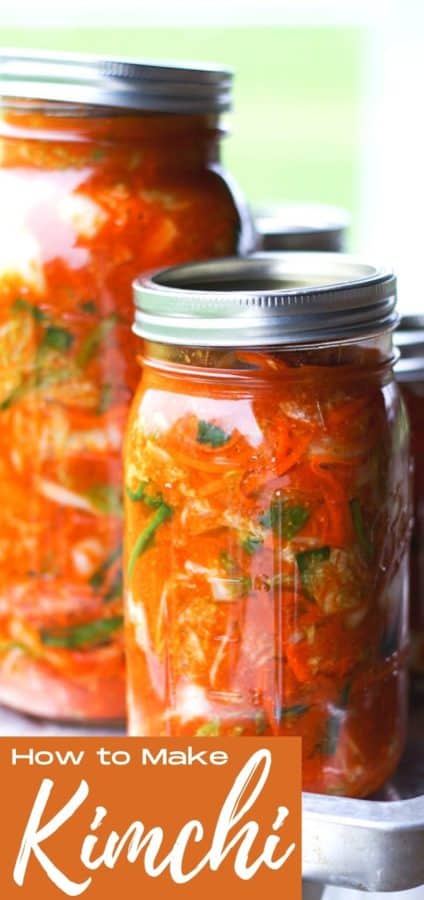
This post was originally published on December 2, 2013 and was updated December 28, 2016, June 2018, and September 2021.
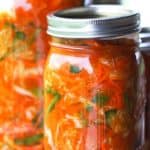



Reader's Thoughts...
Allan F. Cooley says
Kim chi is delicious.., but NO fish sauce for me!
Meg A Howard says
Hi Rebecca,
I am on my second round of this amazing Kimchi recipe! I wonder why we need to stuff the jars so full that they overflow while fermenting. Could we leave the jar partly empty so the brine does not overflow?
Rebecca says
Hi Meg- Thanks so much for taking the time to let me know you love it and rate the recipe. You can certainly pack less into a jar to leave room, but you do need to pack it. Packing it to the top helps hold things in place, but you could add a weight to the jar to hold the veg down!
Tony says
I’m actually shocked this was as good as it was. 4 days into this and it was awesome.
Rebecca says
Fantastic, Tony! Thanks so much for taking the time to rate the recipe and let me know you like it!
Yvonne says
Hi I put mine in my pantry, it’s the second day and it’s not bubbling a tall, is that normal?
Thank you,Yvonne
Rebecca says
Hi Yvonne! Give it another day to see what’s going on!
Mia says
I have to greatly reduce my sodium intake, how much can I reduce so it will still ferment? I don’t mind salting it later so it tastes good, I am just worrying about fermentation.
Rebecca says
Hi Mia- Unfortunately, I’m not sure how much you could reduce it and ensure safe fermentation. I’m sorry!
Rosemarie says
Can regular cabbage be used as a substitute for Chinese cabbage?
Rebecca says
You betcha! It’ll be slightly different -of course- and make take slightly longer -of course- but it should be tasty!
Evelyn says
When I click the white miso paste it doesn’t go to the miso paste that you recommend. Could you tell me what you use?
Rebecca says
Sure thing! I love this one! https://amzn.to/3l2eU7g
Susan Quinn says
What do you mean “If you need extra brine “. There IS no brine. Am I supposed to make a brine and add it to what’s in the jar? I don’t get it.
Rebecca says
Hi Susan- I mean if the liquid that the vegetables give off doesn’t rise to that level, you add brine. As the printable recipe says in the notes: “If you need extra brine to keep your vegetables submerged, please combine 1 quart of cool water with 4 teaspoons of kosher salt in a quart jar with a tight fitting lid and shake until the salt is dissolved. Use it to top off the vegetables as needed.”
Rachel says
Love this recipe, making it for the second time and shared it with multiple friends. Thank you!
I liked the joke at the end “last for up to six months” 😂 not with me around it doesn’t!
Rebecca says
HA! Thank you, Rachel!
Jeanette Mitchell says
I made it and it’s delicious! I added been sprouts because I love them. Next time I’m going to omit the carrots cause I don’t like them. I’m going to add dried shrimp if I can find the tiny ones at my international market. Glad I tried this recipe out of all the ones I reviewed. It’s quick and easier than most of the others, and I was able to easily find all of the ingredients. Thank you!
PS – I would add a picture if I could.
Rebecca says
I’m so glad you love it, Jeanette! I’d love it if you join our facebook community and added a picture there!
Susan says
Saying 3 – 8 lbs of cabbage is quite a spread. Do we want something closer to 3 lbs or 8 lbs?
Susan says
OOPs – just re-read the comments and got my answer. No need to reply. Sorry. Will be making this soon!
Clara says
Hello, After fermenting for 72hrs, when I put it in the fridge can I then screw on the lid or does it have to stay loose???? Thanks.
Regards Clara.
Rebecca says
Hi Clara- I’d say you can screw it on a little more tightly, but I still wouldn’t cinch it shut as tightly as possible. 🙂 I prefer to keep mine on top of a plate or small pan in the fridge, as well, just in case of bubbling!
DJhoan says
I saw maangachi version before yours. You use way less fish sauce. Is it because you just drain the brine instead of rinsing the napa after brining? i will definitely try your recipe next time.
Rebecca says
Hi DJhoan! While I love fish sauce, I prefer for my kimchi funk to come more from the natural fermentation of the cabbage rather than the fish sauce. 🙂 I’m not sure what Maangchi’s version is, but the amount I have in my recipe is my preferred level. 🙂
Martha Campbell says
Super easy to make and delicious! My husband asked why it took me all these years to make him fresh kimchi….
Aaron says
Can’t wait to make this. Heads up though. Your Affiliate link for the white miso paste is linked to the pear juice. The others seem fine though.
Ciara says
Hi, this recipe looka great, thanks for sharing. I wanted to ask you, i have Gochujang paste rather than chili powder. How could I use in this recipe? Can I leave out the miso paste and pear juice, and use the Gochujang paste instead?
Thanks for your advice!
Rebecca says
Hi Ciara- You’d be in uncharted territory for this recipe doing that, but theoretically it should work. I just haven’t tried it. 🙂
Sue says
I made the kimchi 24 hours ago and have not seen any bubbling yet. Is it possible I did not add enough juice? If so, can I add some more sugar at this point
Rebecca says
Hi Sue- It’s definitely possible that you need to add more brine! You can stir 4 teaspoons of kosher salt into 1 quart of cool, unchlorinated water then top your jar off. I wouldn’t add more sugar, personally. 🙂
brown says
I know this is old post.. hope I get answer to my questions… Can I use Oyster sauce instead of fish sauce and WHY white miso? I have the yellow miso on hand.. an I find up whole (dried) Korean chiles for the powdered? or do I have to buy specific Korean Chile powder?
Thank you in advance and hope I get some answers!
Rebecca says
I still see comments, Brown 🙂 Yes to a go on yellow miso. Go for it. I’d skip oyster sauce if you can’t find fish sauce. You can certainly grind your own chile peppers as long as they’re the ones gochugaru is made of! You may end up with hotter or milder kimchi than intended, though, because the grind may be coarser or finer if you DIY it. 🙂
Tom says
This recipe is delicious and easy! One question you say to add extra brine to keep vegetables covered is the brine the water and salt brining in the beginning of the process or? Thank you
Rebecca says
Hey Tom! Did you mean to rate this recipe one star if it is delicious and easy? 🙂
You’ll want to mix up a brine of 1 quart cool water with 4 teaspoons of kosher salt and use as much of that as needed to top off your vegetables. 🙂
Brian says
I made this and it’s delicious. Used the crazy korean e-Jen fermenter. I’m curious tho, it’s very dry. Whenever I make pickles or kraut there’s always a brine to push the stuff under. There was in the fermenter, sort of, but when I transferred it to jars there’s no liquid to sit under and I’m concerned it’ll go bad. I tried squishing it down but with this recipe there isn’t enough liquid when it’s done to squish down enough to stay covered. Unless I misunderstood a step that is!
Rebecca says
Hi Brian- There is a step in there that says if your mixture is too dry to top off the jar with brine. 🙂
I’m so glad you like it, too! 🙂